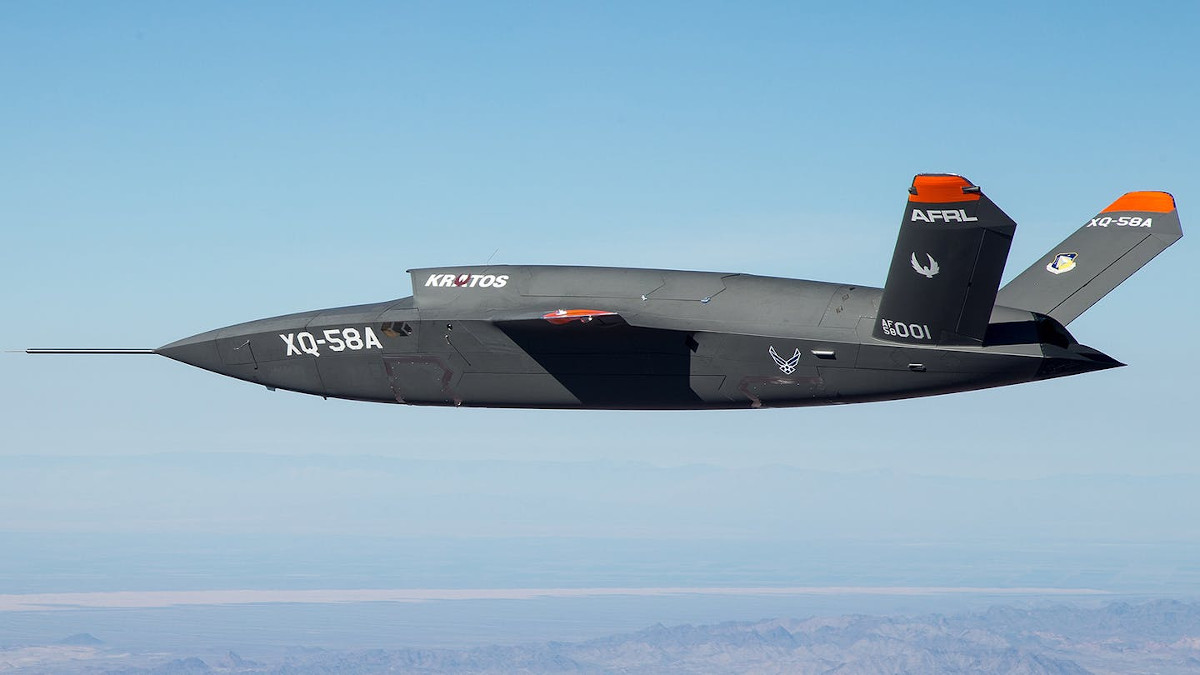The Air Force says that its Kratos XQ-58A Valkyrie unmanned aircraft sustained some amount of damage in a recent mishap. The drone had just completed its third flight under the Low Cost Attritable Strike Demonstration program, or LCASD, which the service says was otherwise successful.
The accident occurred on Oct. 9, 2019, after the XQ-58A had landed at Yuma Proving Ground in Arizona. “High surface winds and a malfunction of the vehicle’s provisional flight test recovery system resulted in a mishap,” according to an official Air Force press release. “The prototype cushion system, which was employed for the initial test series but is not intended for ultimate operational use, suffered an anomaly resulting in the aircraft sustaining damage upon touchdown,” the manufacturer, Kratos, explained in its own statement.
Though past Air Force concept art of a notional low-cost attritable aircraft showed a tricycle landing gear configuration, Kratos has been recovering the XQ-58A after test flights using a traditional parachute recovery system. This means that after the drone finishes its flight, its engine shuts off and it deploys a parachute. Airbags also deploy and cushion the unmanned aircraft when it hits the ground. This is a proven concept that has been in use on drones since the 1970s and it’s unclear how the malfunction occurred in this particular incident.
“We continue to learn about this aircraft and the potential the technology can offer to the warfighter. This third flight successfully completed its objectives and expanded the envelope from the first two flights,” U.S. Air Force Major General William Cooley, head of the Air Force Research Laboratory (AFRL), which is running the LCASD program, said in a statement. “We have gathered a great deal of valuable data from the flight and will even learn from this mishap. Ultimately, that is the objective of any experiment and we’re pleased with the progress of the Low Cost Attritable Strike Demonstration program.”

The test flight itself lasted approximately 90 minutes and saw the XQ-58A fly to higher altitudes and at higher speeds than ever before. The Air Force did not release details on the exact performance parameters.
The Valkyrie had taken its first flight, last approximately 72 minutes, at Yuma on March 5, 2019. The second test sortie, approximately 71 minutes long, took place on June 11, 2019.
Kratos first received a contract to develop the XQ-58A for the LCASD program in 2016. This demonstration effort is part of AFRL’s larger Low Cost Attritable Aircraft Technology (LCAAT) project. The general goal is to develop a low-cost unmanned aircraft capable of performing intelligence, surveillance, and intelligence, strike, and electronic warfare missions either on its own, as a loyal wing working together with a manned aircraft, or in a networked autonomous swarm. Kratos has said it is aiming to eventually get the unit price down to at least $2 million, which is a price point that one might expect to see with advanced cruise missiles rather than reusable unmanned stealthy aircraft.
The War Zone has been following this program closely for years and you can read more about it and the potential benefits of these developments here and here. The XQ-58A is also slated to be the first aircraft of any type to flight test the new computer brain that the Air Force is developing under the Sky Borg program, which you can read about in more detail in this past War Zone story. Kratos says it has it already has other, unnamed customers for the Valkyrie beyond the U.S. Air Force, as well.

It is unclear how severe the damage to the XQ-58A is and how it might delay the LCASD test schedule. The Air Force has said that the fourth flight will be postponed until it can complete a formal safety investigation into the mishap.
Kratos says “the damage has been initially evaluated and determined to be fully repairable” and also highlighted that it designed Valkyrie from the beginning to be “quickly repaired and reused if damage is sustained after performing operational missions.” The company also says it plans to fully address the issues with the cushion system in the fourth test flight for AFRL.
Hopefully, the extent of the damage is minimal and the Air Force will not have to significantly delay its continued testing of this exciting unmanned aircraft.
Contact the author: joe@thedrive.com
